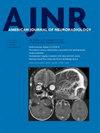神经放射科医生行业薪酬的分布和差异。
IF 3.7
3区 医学
Q2 CLINICAL NEUROLOGY
引用次数: 0
摘要
背景和目的医生与行业的关系有助于推动创新和技术进步,但人们对行业参与神经放射学的规模和影响知之甚少。本研究的目的是评估神经放射医师行业付款的趋势和分布情况。材料和方法采用一种基于工作相对价值单位和 Neiman Imaging 服务类型分类的先前经过验证的方法确定神经放射医师。行业支付数据来自美国医疗保险与医疗补助服务中心(Centers for Medicare & Medicaid Services)的开放支付数据库(Open Payments database),时间为 2016 年至 2021 年。付款分为 7 个类别,包括咨询费、教育、礼品、医疗用品、研究、版税/所有权和演讲费。结果本研究共确定了 3019 名神经放射科医生。在 2016 年至 2021 年期间,48%(1440/3019)的神经放射科医生至少从业界获得过一次报酬,总计 21,967 次。每年,在从业界获得报酬的人员中,每位神经放射科医生获得的报酬平均值为 5.49-7.42 笔,中位数为 2 笔,这表明报酬的分布呈现出强烈的右倾趋势。礼品是最常见的付款类型(60%,13,285/21,967),但只占付款价值的 4.1%(689,859 美元/17,010,546 美元)。总支付价值最高的是演讲费,占总支付价值的 36%(6,127,484 美元/17,010,546 美元)。收入最高的前 5%神经放射科医生获得了 42% 的酬金(9133/211967 美元),占总酬金的 84%(14284120 美元/17010546 美元)。自冠状病毒 2019(COVID-19)大流行开始以来,获得行业付款的神经放射科医师人数从流行前(2016-2019 年)的平均每年 671 人减少到流行后(2020-2021 年)的 411 人(P = .030)。向神经放射科医生支付的总金额从流行前的每年 4177 美元降至流行后的每年 2631 美元(P = .011)。在 COVID-19 大流行期间,支付的数量有所减少,但支付的美元价值被特许权使用费的偶然增加所抵消。需要在随后几年进行进一步调查,以确定大流行后行业付款趋势的变化是否会继续。本文章由计算机程序翻译,如有差异,请以英文原文为准。
Distribution and Disparities of Industry Payments to Neuroradiologists.
BACKGROUND AND PURPOSE
Physician-industry relationships can be useful for driving innovation and technologic progress, though little is known about the scale or impact of industry involvement in neuroradiology. The purpose of this study was to assess the trends and distributions of industry payments to neuroradiologists.
MATERIALS AND METHODS
Neuroradiologists were identified using a previously-validated method based on Work Relative Value Units and Neiman Imaging Types of Service classification. Data on payments from industry were obtained from the Open Payments database from the Centers for Medicare & Medicaid Services, from 2016 to 2021. Payments were grouped into 7 categories, including consulting fees, education, gifts, medical supplies, research, royalties/ownership, and speaker fees. Descriptive statistics were calculated.
RESULTS
A total of 3019 neuroradiologists were identified in this study. Between 2016 and 2021, 48% (1440/3019) received at least 1 payment from industry, amounting to a total number of 21,967 payments. Each year, among those receiving payments from industry, each unique neuroradiologist received between a mean of 5.49-7.42 payments and a median of 2 payments, indicating a strong rightward skew to the distribution of payments. Gifts were the most frequent payment type made (60%, 13,285/21,967) but accounted for only 4.1% ($689,859/$17,010,546) of payment value. The greatest aggregate payment value came from speaker fees, which made up 36% ($6,127,484/$17,010,546) of the total payment value. The top 5% highest paid neuroradiologists received 42% (9133/21,967) of payments, which accounted for 84% ($14,284,120/$17,010,546) of the total dollar value. Since the start of the coronavirus 2019 (COVID-19) pandemic, the number of neuroradiologists receiving industry payments decreased from a mean of 671 neuroradiologists per year prepandemic (2016-2019) to 411 in the postpandemic (2020-2021) era (P = .030). The total number of payments to neuroradiologists decreased from 4177 per year prepandemic versus 2631 per year postpandemic (P = .011).
CONCLUSIONS
Industry payments to neuroradiologists are highly concentrated among top earners, particularly among the top 5% of payment recipients. The number of payments decreased during the COVID-19 pandemic, though the dollar value of payments was offset by coincidental increases in royalty payments. Further investigation is needed in subsequent years to determine if the postpandemic changes in industry payment trends continue.
求助全文
通过发布文献求助,成功后即可免费获取论文全文。
去求助
来源期刊
CiteScore
7.10
自引率
5.70%
发文量
506
审稿时长
2 months
期刊介绍:
The mission of AJNR is to further knowledge in all aspects of neuroimaging, head and neck imaging, and spine imaging for neuroradiologists, radiologists, trainees, scientists, and associated professionals through print and/or electronic publication of quality peer-reviewed articles that lead to the highest standards in patient care, research, and education and to promote discussion of these and other issues through its electronic activities.

 求助内容:
求助内容: 应助结果提醒方式:
应助结果提醒方式:


